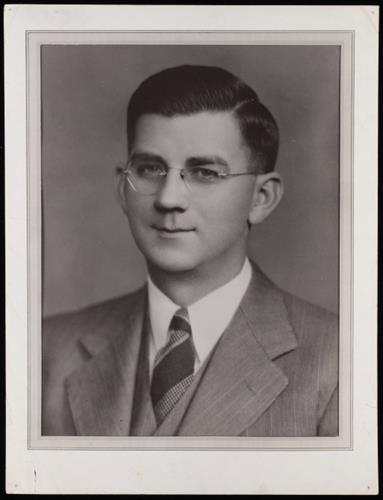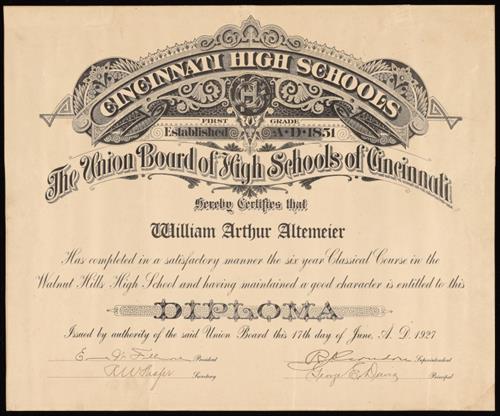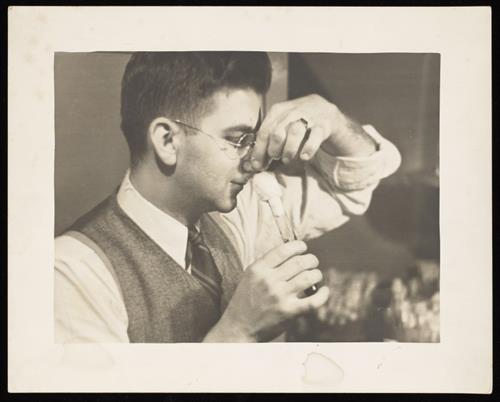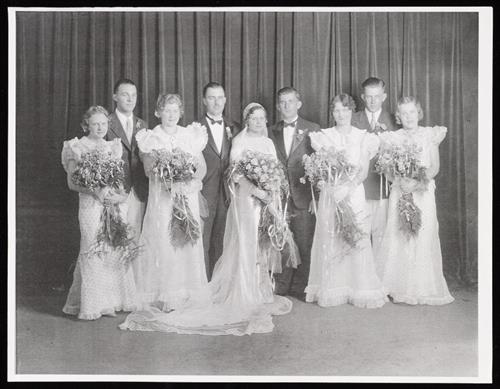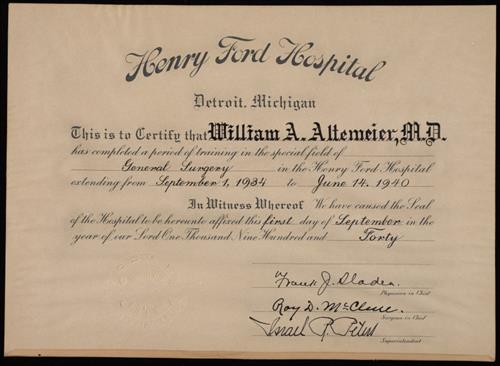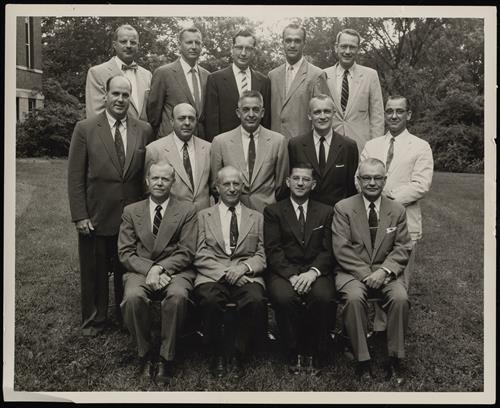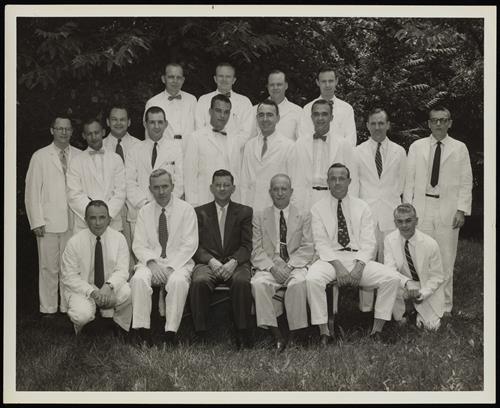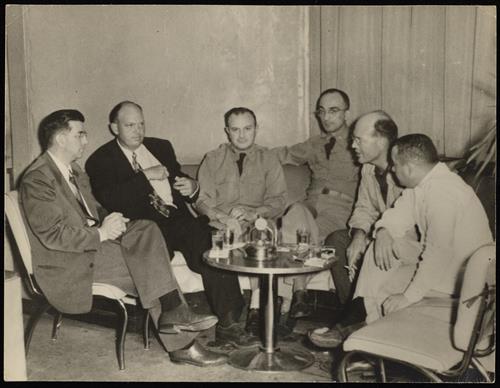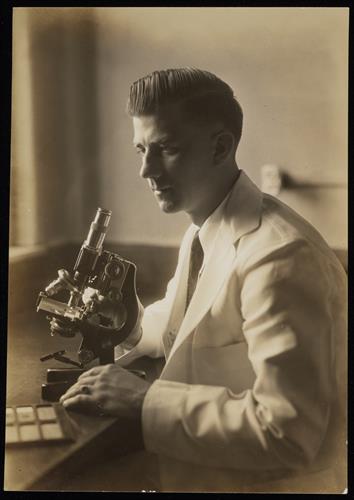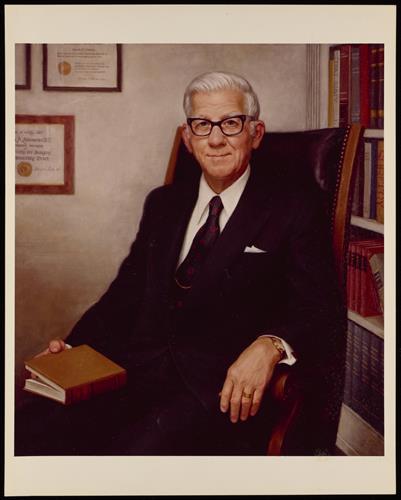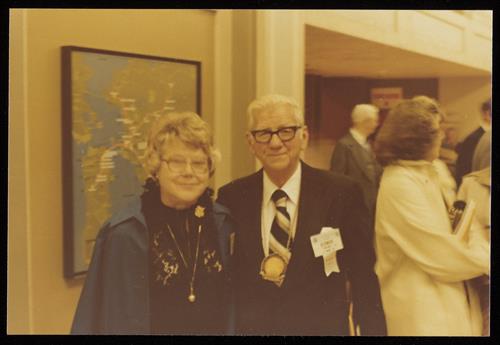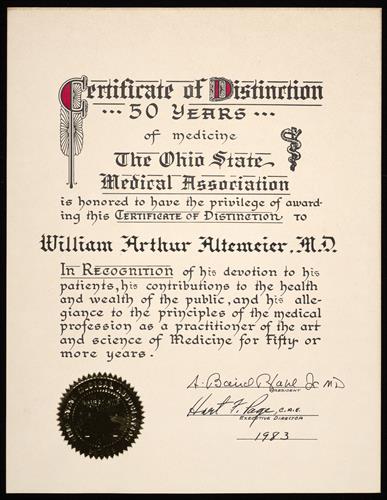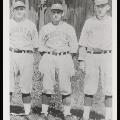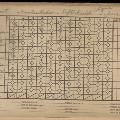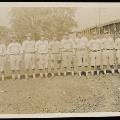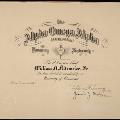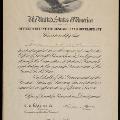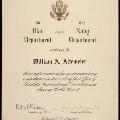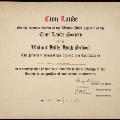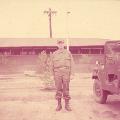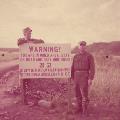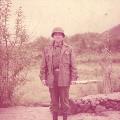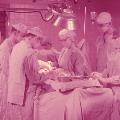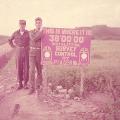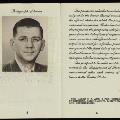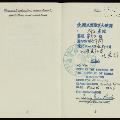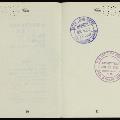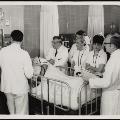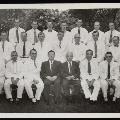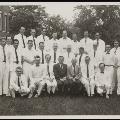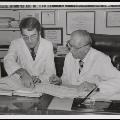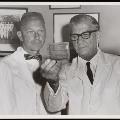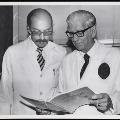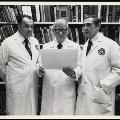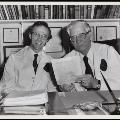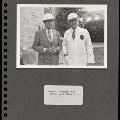William A. Altemeier Collection
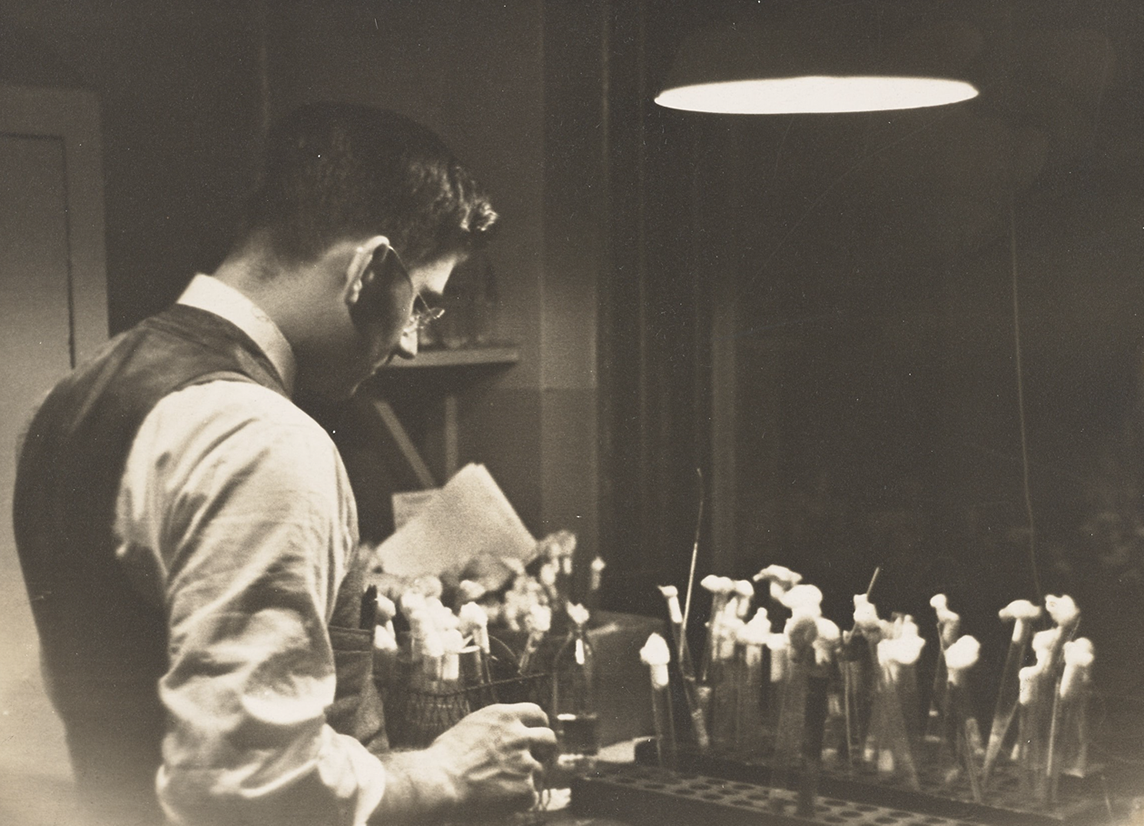
Dr. William A. Altemeier
Dr. William A. Altemeier was a graduate of the University of Cincinnati’s College of Medicine, Christian R. Holmes Professor and Chairman of the University of Cincinnati’s Department of Surgery, and renowned surgeon. This exhibit represents some of the key work, moments, and achieve-ments of Dr. Altemeier’s life. Content from the exhibit is sourced from the William A. Altemeier Collection, located in the Winkler Center for the History of Health Professions Archives. The exhibit and processing of the collection was made possible by a gift of funding from the family of Dr. William A. Altemeier.
Timeline
On July 6, 1910 William Arthur Altemeier, Jr. is born to William Arthur Altemeier and Carrie Moore Altemeier in Cincinnati, Ohio.
Altemeier graduates Cum Laude from Walnut Hills High School on June 17, 1927 at the age of 16. Inspired to be a physician from the age of 10, he immediately enrolls at the University of Cincinnati to attend the College of Medicine, passing on an opportunity to play catcher for the St. Louis Cardinals baseball team.
In 1933, William A. Altemeier became Dr. William A. Altemeier when he earned his M.D. from the University of Cincinnati College of Medicine. As a student, Altemeier had taken a keen interest in bacteriology. He studied surgery under Dr. Mont Reid, where he decided to use his interest in bacteria to advance the field of surgery.
On June 16, 1934, William Altemeier married Edna Ann Wyss. They were married for 40 years, until her passing in 1975, and had three children together – William Jr., Ann, and George. When William Jr. was born, they were living in the slums of Detroit, MI while Dr. Altemeier was completing his residency at Henry Ford Hospital. They had to continuously move William Jr.’s crib out of fear the rats would attack him.
Dr. Altemeier continued his studies at the University of Michigan, earning his Masters of Science in Surgery in 1938. He then completed another internship at the Henry Ford Hospital in Detroit under Dr. Roy McClure. His first major contributions to the surgical field came during this time, reporting heavily on the microbiology of intra-abdominal infections.
Following a year of teaching at Henry Ford Hospital, Dr. Altemeier returned to the University of Cincinnati in 1940 as a member of the faculty in the Department of Surgery, under the direction of Dr. Mont Reid. Dr. Reid was followed as director by Dr. Max Zinninger from 1943-1946, and then by Dr. B. Noland Carter, from 1946-1952. Those three directors, as well as their predecessor and first Christian R. Holmes Professor of Surgery, Dr. George Heuer, were known as the "Hopkins Invasion". They had come to the University of Cincinnati from Johns Hopkins Medical School in 1922 to start the new surgical residency program modeled by Dr. William Stewart Halsted.
1952 saw Dr. Altemeier appointed to serve as the Christian R. Holmes Professor and Chairman of the Department of Surgery at the University of Cincinnati. He was the first professor and chairman after the Hopkins invasion, which had begun 30 years prior. He continued the department's focus on surgical infections and microbiology. Altemeier contributed greatly to the University of Cincinnati College of Medicine's reputation in leadership with such responsibilities and initiatives as overseeing the construction of the largest medical college ever constructed and the development of the surgical research building.
In 1953, Dr. Altemeier was asked to volunteer as a civilian to work with surgeons in treating surgical infections at various Mobile Army Surgical Hospitals, or MASH as they are more commonly known, in Korea. He talked so much of his trip about what he learned and his experiences, such as an engine on his plane catching fire, that for years afterward his colleagues referred to him as "Korea Bill".
In 1970, Dr. Altemeier was recognized for his outstanding advances in the field of Surgery by the National Institutes of Health. At the time, he had published over 200 articles on surgical procedures, surgical infections, and microbiology. He had also served in Korea as a MASH civilian, performed scientific research for the War and Navy Departments, and directed one of the top medical college surgical departments in the country for nearly 20 years. Years later, in 1985, the National Library of Medicine would commit to preserving the memory of Dr. Altemeier by receiving some of his works, including awards & certificates, photographs, and correspondence.
Dr. Altemeier retired as Chairman of the Department of Surgery in 1978, after serving for 25 years. In that time, he had also served as the Director of Surgical Services at the Cincinnati General Hospital and Surgeon-in-Chief at the Children's and Holmes Hospitals and Consulting Surgeon at Dunham, Drake, and Veteran's Affairs Hospitals in Cincinnati. He was instrumental in bringing the Veteran's Affairs hospital and the Shriners Burns Institute to Cincinnati, as well as in the expansion and construction of several University of Cincinnati Medical Campus buildings. His work would be further memorialized with the construction of the Altemeier Surgical Research Library after his death.
Dr. Altemeier's wife, Edna, passed away on March 2, 1975. As she was losing her battle with cancer, Edna suggested to Dr. Altemeier that he marry her best friend, Dorothea Wertz. Dorothea was a long-time friend of Dr. Altemeier also, as she was also his secretary for four decades. She was present at the marriage of Dr. Altemeier and Edna, and can be seen in the far right of their wedding photograph above. She was a welcomed and loved member of the Altemeier family until her passing at the age of 90.
Dr. Altemeier passed away on October 23, 1983 at the Holmes Hospital which he had presided over for so long. He was honored in the Cincinnati Post and Enquirer, the University of Cincinnati News Record, and by the many organizations he participated in. Lectures are given annually in his name for the Surgical Infection Society as well as the Shock Society. His works are preserved and accessible at the National Library of Medicine in Bethesda, Maryland, and at the Henry R. Winkler Center for the History of the Health Professions at the University of Cincinnati in Cincinnati, Ohio.
Dr. Altemeier's Life in Pictures
Off The Clock
Despite leading the busy life of a surgeon, teacher, university departmental director, researcher, and leader of countless organizations, Dr. Altemeier managed to squeeze in a little time for his own interests. In his younger days, Altemeier was a star baseball player, and had several crooked fingers from his position as catcher. At one point he was offered a position in the minor leagues, but had turned it down and dedicated himself to his medical career. Later in life, he had become an active and prominent member of the Free & Accepted Masons, through which he had been initiated into the Royal Order of Jesters
Honors and Achievements
Dr. Altemeier was a dedicated learner and active citizen throughout his life. He received recognition for his hard work early in life, with such honors as graduating cum laude from Walnut Hills High School. His dedication and hard work was recognized throughout his career, such as being honored with a certificate of distinction for 50 years of dedicated medical practice from the Ohio State Medical Association.
Service to Country
Dr. Altemeier was called to serve his country during the Korean War by reviewing surgical activities in military hospitals. While his primary duty was to study infections and treatment, he was still able to do some sight seeing and watch some baseball games. This gallery includes images of Altemeier at various military hospitals and landmarks, as well as images from his special passport for travel to South Korea. His report written to Major General William E. Shambora is provided in the Publications section below.
Altemeier and his Colleagues
After over 30 years dedicated to the University of Cincinnati College of Medicine, Altemeier had certainly left his mark on his colleagues and students. This gallery contains images of Altemeier in service to the university alongside some of his peers. If you are able to identify anybody in these photos, the Henry R. Winkler Center for the History of the Health Professions would love to hear from you! Please email chhp@ucmail.uc.edu
Publications
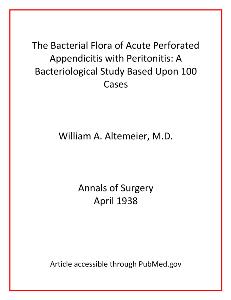
"The Bacterial Flora of Acute Perforated Appendicitis with Peritonitis: A Bacteriological Study Based Upon 100 Cases" was Altemeier's followup to a previous report on 252 consecutive cases of acute perforated appendicitis with peritonitis, which he had authored with Dr. Roy D. McClure during his surgical residency at Henry Ford Hospital. It was Altemeier's first major contribution to the study of infections in surgical patients. Article is accessible to read through PubMed.gov.
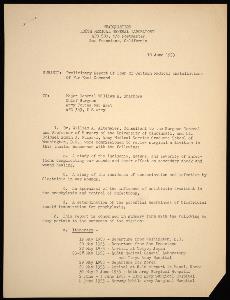
In 1953, Dr. Altemeier was commissioned to review the surgical activities taking place in the Korean War, primarily concerned with frequency and severity of infections from war wounds. The report details cases Dr. Altemeier and Lt. Colonel Edwin J. Pulaski investigated through their tour of South Korea, with an analysis and recommendations. The report is freely accessible through the University of Cincinnati Digital Resource Commons.
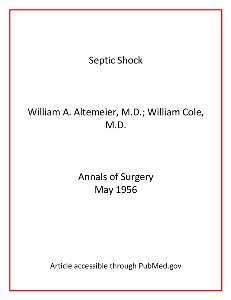
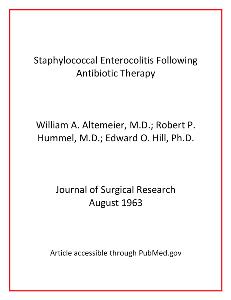
Staphylococcal Enterocolitis is a complication that has offered challenges to surgeons and patients alike. Drs. Altemeier, Hummel, and Hill study 155 patients with staphylococcal enterocolitis. Through their investigation, they reveal the bacteriological aspects of the disease as well as its sensitivity patterns to antibiotic treatment. Article freely accessible through PubMed.gov.
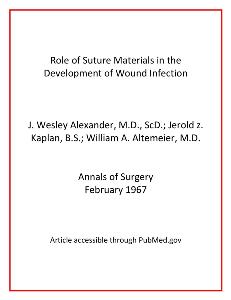
Surgeons have been on the lookout for the perfect, all-purpose suture material for over 500 years. Drs. Altemeier, Alexander, and Kaplan add to the historic conversation by studying the role of suture material in wound infections. This article reports their findings when testing the ability of different suture materials to resist staphylococci. They conclude with a comparison of the suitability of the different material tested in suturing wounds for preventing infection. Article freely accessible through PubMed.gov.
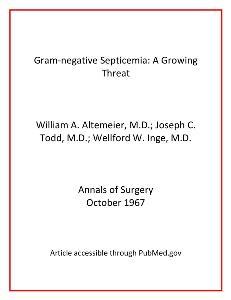
Medical doctors have noticed that despite the use and improvement of antibacterial agents in hospitals, incidences and the severity of Gram-negative septicemia have been getting progressively worse. Drs. Altemeier, Todd, and Inge report on their study of all patients that have been reported to have the infection at Cincinnati General Hospital, the Veterans Administration Hospital, and all other University of Cincinnati Hospitals. Their study identifies the contributing factors leading to Gram-negative septicemia, as well as its influence on the prognosis of hospital patients. Article freely accessible through PubMed.gov.
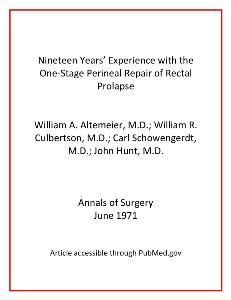
Drs. Altemeier, Culbertson, Schowengerdt, and Hunt share their experience in treating rectal prolapse with the one stage perineal procedure. In their article, they explain their findings of three major types of rectal prolapse; document their results of the procedure; address some misconceptions of the procedure; and address some of the unique factors related to rectal prolapse. Article freely accessible through PubMed.gov.
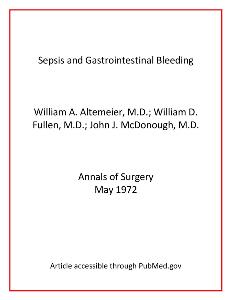

Staphylococcus – Our Worthy Adversary was a lecture delivered to the Surgical Infection Society by Dr. Altemeier. He passes on the knowledge and experience he had over the previous 50 years of his life to the society. Dr. Altemeier was one of the founders, and first president of the Surgical Infection Society. The society continues to honor him through the annual William A. Altemeier Lectures at it's annual meeting. The speech in it's entirety is freely accessible through the University of Cincinnati Digital Resource Commons.
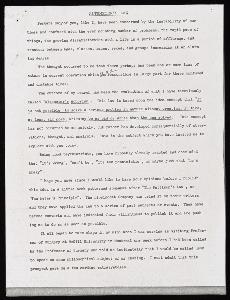
In his life and through his work, Dr. Altemeier had seen a lot of problems and solved a lot of problems. He also saw a lot of problems created by solutions to other problems. In time, he developed what he called "Altemeier's Aphorism", which states that "it is not possible to solve a serious problem in nature without creating, in time, at least six more which may be as bad or worse than the one solved". This manuscript provides several illustrations of solutions to problems which had led to other problems, and concludes with his thoughts on how the expanding number of problems created by solutions will impact the medical community. The manuscript is freely accessible through the University of Cincinnati's Digital Resource Commons.


